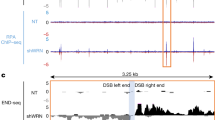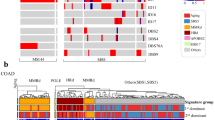Abstract
Frequent mutations of coding nucleotide repeats are thought to contribute significantly to carcinogenesis associated with microsatellite instability (MSI). We have shown that shortening of the poly(T)11 within the polypyrimidine stretch/accessory splicing signal of human MRE11 leads to the reduced expression and functional impairment of the MRE11/NBS1/RAD50 complex. This mutation was selectively found in mismatch repair (MMR) defective cell lines and potentially identifies MRE11 as a novel target for MSI. Here, we examined 70 microsatellite unstable primary human cancers and we report that MRE11 mutations occur in 83.7 and 50% of the colorectal and endometrial cancers, respectively. In the colorectal cancer series, mutated MRE11 is more frequently associated with advanced age at diagnosis and A/B stages. Biallelic mutations were present in 38.8% of the cases and more frequently associated with lower (G1/G2) grade tumors. Impaired MRE11 expression was prevalent in primary colorectal tumors with larger and biallelic shortening of the poly(T)11. Immunohistochemistry confirmed the impaired MRE11 expression and revealed NBS1-defective expression in MRE11 mutated cancers. Together with the observation that perturbation of the MRE11/NBS1/RAD50 complex predisposes to cancer, our work highlights MRE11 as a new common target in the MMR deficient tumorigenesis and suggests its role in colorectal carcinogenesis.
This is a preview of subscription content, access via your institution
Access options
Subscribe to this journal
Receive 50 print issues and online access
$259.00 per year
only $5.18 per issue
Buy this article
- Purchase on Springer Link
- Instant access to full article PDF
Prices may be subject to local taxes which are calculated during checkout





Similar content being viewed by others
References
Aaltonen LA, Peltomaki P, Leach FS, Sistonen P, Pylkkanen L, Mecklin JP, Jarvinen H, Powell SM, Jen J, Hamilton SR, Petersen GM, Kinzler KW, Vogelstein B and de la Chapelle A . (1993). Science, 260, 812–816.
Bell DW, Varley JM, Szydlo TE, Kang DH, Wahrer DC, Shannon KE, Lubratovich M, Verselis SJ, Isselbacher KJ, Fraumeni JF, Birch JM, Li FP, Garber JE and Haber DA . (1999). Science, 286, 2528–2531.
Bender CF, Sikes ML, Sullivan R, Huye LE, Le Beau MM, Roth DB, Mirzoeva OK, Oltz EM and Petrini JH . (2002). Genes Dev., 16, 2237–2251.
Boland CR, Thibodeau SN, Hamilton SR, Sidransky D, Eshleman JR, Burt RW, Meltzer SJ, Rodriguez-Bigas MA, Fodde R, Ranzani GN and Srivastava S . (1998). Cancer Res., 58, 5248–5257.
Carney JP, Maser RS, Olivares H, Davis EM, Le Beau M, Yates III JR, Hays L, Morgan WF and Petrini JH . (1998). Cell, 93, 477–486.
Casorelli I, Offman J, Mele L, Pagano L, Sica S, D'Errico M, Giannini G, Leone G, Bignami M and Karran P . (2003). DNA Repair (Amsterdam), 2, 547–559.
D'Amours D and Jackson SP . (2002). Nat. Rev. Mol. Cell Biol., 3, 317–327.
Duval A and Hamelin R . (2002). Cancer Res., 62, 2447–2454.
Duval A, Reperant M and Hamelin R . (2002). Oncogene, 21, 8062–8066.
Fleiss JH . (1981). Statistical Methods for Rates and Proportions. John Wiley & Sons: New York, NY, pp 212–236.
Fukuda T, Sumiyoshi T, Takahashi M, Kataoka T, Asahara T, Inui H, Watatani M, Yasutomi M, Kamada N and Miyagawa K . (2001). Cancer Res., 61, 23–26.
Giannini G, Ristori E, Cerignoli F, Rinaldi C, Zani M, Viel A, Ottini L, Crescenzi M, Martinotti S, Bignami M, Frati L, Screpanti I and Gulino A . (2002). EMBO Rep., 3, 248–254.
Hangaishi A, Ogawa S, Qiao Y, Wang L, Hosoya N, Yuji K, Imai Y, Takeuchi K, Miyawaki S and Hirai H . (2002). Blood, 99, 3075–3077.
Ionov Y, Peinado MA, Malkhosyan S, Shibata D and Perucho M . (1993). Nature, 363, 558–561.
Kang J, Bronson RT and Xu Y . (2002). EMBO J., 21, 1447–1455.
Kim NG, Choi YR, Baek MJ, Kim YH, Kang H, Kim NK, Min JS and Kim H . (2001). Cancer Res., 61, 36–38.
Kim NG, Rhee H, Li LS, Kim H, Lee JS, Kim JH and Kim NK . (2002). Oncogene, 21, 5081–5087.
Markowitz S, Wang J, Myeroff L, Parsons R, Sun L, Lutterbaugh J, Fan RS, Zborowska E, Kinzler KW, Vogelstein B, Brattain H and Wilson JKV . (1995). Science, 268, 1336–1338.
Matsuoka S, Nakagawa T, Masuda A, Haruki N, Elledge SJ and Takahashi T . (2001). Cancer Res., 61, 5362–5365.
Mori Y, Sato F, Selaru FM, Olaru A, Perry K, Kimos MC, Tamura G, Matsubara N, Wang S, Xu Y, Yin J, Zou TT, Leggett B, Young J, Nukiwa T, Stine OC, Abraham JM, Shibata D and Meltzer SJ . (2002). Cancer Res., 62, 3641–3645.
Park J, Betel D, Gryfe R, Michalickova K, Di Nicola N, Gallinger S, Hogue CW and Redston M . (2002). Cancer Res., 62, 1284–1288.
Parsons R, Li GM, Longley MJ, Fang WH, Papadopoulos N, Jen J, de la Chapelle A, Kinzler KW, Vogelstein B and Modrich P . (1993). Cell, 75, 1227–1236.
Peltomaki P . (2001). Hum. Mol. Genet., 10, 735–740.
Perucho M . (2003). Oncogene, 22, 2223–2225.
Rampino N, Yamamoto H, Ionov Y, Li Y, Sawai H, Reed JC and Perucho M . (1997). Science, 275, 967–969.
Schaffner C, Idler I, Stilgenbauer S, Dohner H and Lichter P . (2000). Proc. Natl. Acad. Sci. USA, 97, 2773–2778.
Shiloh Y . (2003). Nat. Rev. Cancer, 3, 155–168.
Souza RF, Appel R, Yin J, Wang S, Smolinski KN, Abraham JM, Zou TT, Shi YQ, Lei J, Cottrell J, Cymes K, Biden K, Simms L, Leggett B, Lynch PM, Frazier M, Powell SM, Harpaz N, Sugimura H, Young J and Meltzer SJ . (1996). Nat. Genet., 14, 255–257.
Stankovic T, Weber P, Stewart G, Bedenham T, Murray J, Byrd PJ, Moss PA and Taylor AM . (1999). Lancet, 353, 26–29.
Stewart GS, Maser RS, Stankovic T, Bressan DA, Kaplan MI, Jaspers NG, Raams A, Byrd PJ, Petrini JH and Taylor AM . (1999). Cell, 99, 577–587.
Tessitore A, Biordi L, Flati V, Toniato E, Marchetti P, Ricevuto E, Ficorella C, Scotto L, Giannini G, Frati L, Masciocchi C, Tombolini V, Gulino A and Martinotti S . (2003). Genes Chromosomes Cancer, 36, 198–204.
Thibodeau SN, Bren G and Schaid D . (1993). Science, 260, 816–819.
Varon R, Reis A, Henze G, von Einsiedel HG, Sperling K and Seeger K . (2001). Cancer Res., 61, 3570–3572.
Woerner SM, Benner A, Sutter C, Schiller M, Yuan YP, Keller G, Bork P, Doeberitz MK and Gebert JF . (2003). Oncogene, 22, 2226–2235.
Xiao Y and Weaver DT . (1997). Nucleic Acids Res., 25, 2985–2991.
Zhang L, Yu J, Willson JK, Markowitz SD, Kinzler KW and Vogelstein B . (2001). Cancer Res., 61, 3801–3805.
Acknowledgements
We are grateful to Dr M Levrero for critical reading of the manuscript. This work was supported by grants from Associazione Italiana per la Ricerca sul Cancro, Ministry of Health, the National research Council (CNR), the Ministry of University and Research, the Pasteur Institute, Cenci-Bolognetti Foundation.
Author information
Authors and Affiliations
Corresponding author
Rights and permissions
About this article
Cite this article
Giannini, G., Rinaldi, C., Ristori, E. et al. Mutations of an intronic repeat induce impaired MRE11 expression in primary human cancer with microsatellite instability. Oncogene 23, 2640–2647 (2004). https://doi.org/10.1038/sj.onc.1207409
Received:
Revised:
Accepted:
Published:
Issue Date:
DOI: https://doi.org/10.1038/sj.onc.1207409
Keywords
This article is cited by
-
Microsatellite instability assessment is instrumental for Predictive, Preventive and Personalised Medicine: status quo and outlook
EPMA Journal (2023)
-
The epigenetic modifier HDAC2 and the checkpoint kinase ATM determine the responses of microsatellite instable colorectal cancer cells to 5-fluorouracil
Cell Biology and Toxicology (2023)
-
Potential risks associated with the use of ionizing radiation for imaging and treatment of colorectal cancer in Lynch syndrome patients
Familial Cancer (2023)
-
Nucleases as molecular targets for cancer diagnosis
Biomarker Research (2021)
-
Lack of MRE11-RAD50-NBS1 (MRN) complex detection occurs frequently in low-grade epithelial ovarian cancer
BMC Cancer (2017)



